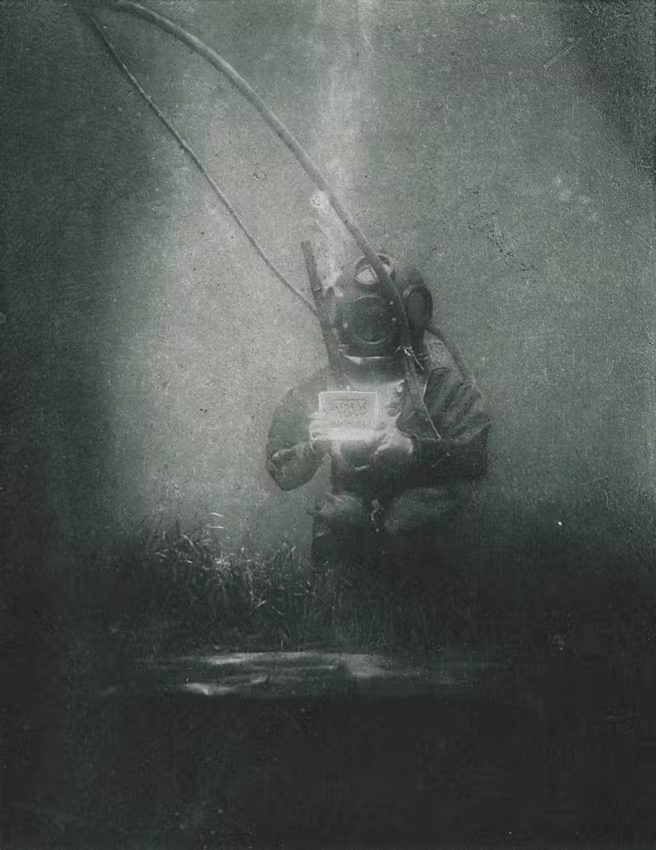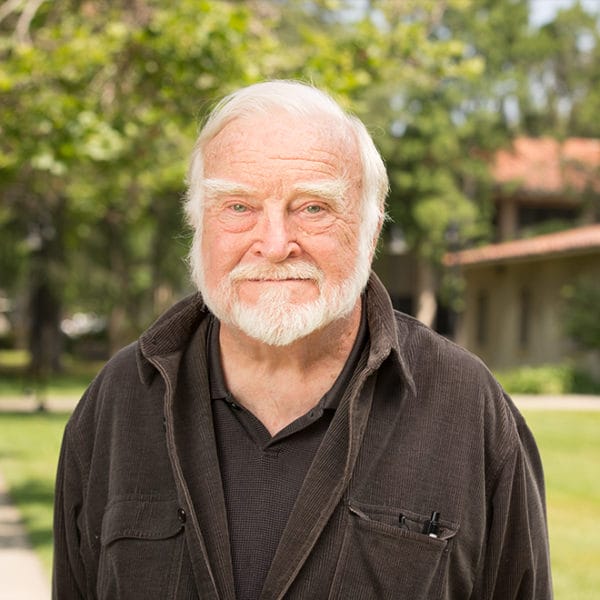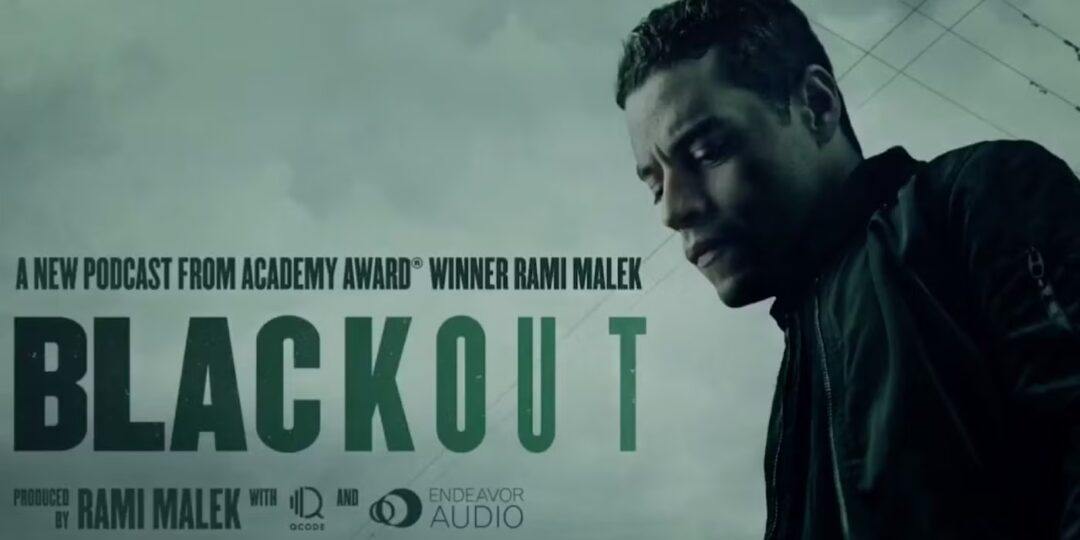Módulo 1: ¿Qué significa estar inmerso?
Una introducción a los fundamentos espaciales, perceptuales y narrativos de la experiencia inmersiva.

Retrato instantáneo de un buzo, una fotografía submarina de Louis Boutan, 1899.
Hablar del sonido es hablar del espacio. Cada fuente sonora ocupa una posición, se proyecta y se transforma según el entorno físico en el que se emite. El sonido no existe de manera aislada: siempre está incrustado en un espacio específico.
Cuando hablamos de audio inmersivo, no nos referimos solo a cómo el sonido interactúa con el entorno físico, sino también a cómo se comporta dentro de los espacios virtuales. Esto introduce una capa adicional: la experiencia del usuario se construye en la intersección entre el espacio físico que habita y el entorno virtual que lo rodea, un espacio contenido dentro de otro espacio.
No todas las obras inmersivas tienen lugar en entornos físicos. Tampoco se desarrollan exclusivamente en entornos virtuales. En muchos casos, la obra se despliega en un territorio híbrido. Y ese territorio no es solo técnico: también es narrativo y perceptual.
La forma en que se distribuye el sonido, el tipo de historia que se cuenta, los dispositivos de escucha disponibles, la calidad del audio, el grado de participación del usuario y el realismo sonoro: todas estas son variables que moldean la construcción de una experiencia inmersiva.
En este contexto, surgen varias preguntas clave:
¿Cuántas fuentes sonoras se necesitan para crear una sensación de inmersión?
¿Qué determina que un usuario se sienta dentro de una narrativa sonora?
¿Qué papel juegan el cuerpo, la atención, la expectativa y la memoria en esa experiencia?
¿Qué separa —o conecta— al mundo físico del mundo virtual en una obra sonora?
Pensar el sonido desde la perspectiva de la espacialidad también implica reflexionar sobre cómo se percibe, cómo se interpreta y cómo se habita.
INMERSIVO
El término inmersivo comparte su raíz etimológica con verbos como sumergir y inundar.Todos se refieren a una experiencia de inmersión total, en la que un cuerpo queda completamente rodeado por un entorno.
Inundar proviene del latín inundāre: ocupar un espacio con una sustancia fluida, saturar un territorio. No se trata solo de presencia, sino de desplazamiento. Lo que inunda cambia lo que estaba allí. Lo cubre, lo transforma y lo redefine.
Aplicado al sonido, el concepto de inmersión no implica solo el envolvimiento físico. Involucra una reorganización perceptual: un territorio sonoro que interfiere con el estado previo del oyente y lo coloca en una relación diferente con el espacio, el tiempo y la atención.
La inmersión, entonces, no es simplemente una característica técnica. Es una forma de experimentar, de relacionarse con lo que se escucha. Es un proceso que afecta tanto al contenido como al receptor.
Condiciones para la inmersión narrativa
Estar inmerso en una narrativa requiere varios elementos interdependientes:
La duración total de la experiencia.
El entorno físico del oyente.
El espacio sonoro construido para la narración.
La forma en que se presenta el contenido para mantener el interés.
La gestión del tiempo interno de la obra.
Los modos de acceso e interacción que el oyente tiene con la narrativa.
En el campo del diseño de experiencias, la industria de los videojuegos adopta el concepto de experiencia óptima o flujo, formulado por Mihaly CsikszentmihalyiEste enfoque proporciona un marco para pensar en las condiciones necesarias para lograr una experiencia inmersiva.

Mihaly Csikszentmihalyi
Según Csikszentmihalyi, una experiencia de flujo ocurre cuando se cumplen los siguientes ocho criterios:
La actividad implica tareas claras y bien definidas.
Es posible mantener una concentración ininterrumpida.
Existen metas definidas.
Se proporciona retroalimentación inmediata sobre las acciones.
La participación se vuelve profunda y aparentemente sin esfuerzo, permitiendo que las preocupaciones externas se desvanezcan.
Se percibe una sensación de control sobre las propias decisiones dentro del entorno.
La autoconciencia desaparece. Esto solo es posible si el entorno se percibe como seguro. En el contexto sonoro, esto se ve comprometido cuando los sonidos son excesivamente fuertes, cuando múltiples frecuencias se saturan simultáneamente o cuando se ignoran los sonidos reales del entorno que interactúan con la obra.
La percepción del paso del tiempo se ve alterada.
Aplicar estos principios al diseño sonoro significa considerar no solo la ubicación espacial de los sonidos, sino también su temporalidad. Cuándo ocurre un sonido, durante cuánto tiempo, cómo se transforma y en qué contexto: estas son decisiones clave.
La inmersión no se logra simplemente distribuyendo sonidos en el espacio. Requiere una articulación precisa entre espacio, tiempo, contenido y percepción.

Ejercicio: En la oscuridad del espacio
Objetivo: Explora cómo la espacialización y la información verbal modifican la percepción sonora y narrativa.
Duración: 15 minutos.
Introducción:
En este ejercicio, trabajaremos con el tráiler del podcast Blackout, protagonizado y producido por Rami Malek (conocido por su papel en Mr. Robot). Lanzado en 2019, el podcast consta de ocho episodios y se sitúa en un mundo que enfrenta un colapso eléctrico total. En este contexto, las tecnologías a gran escala fallan y surgen tensiones entre el caos, la supervivencia y la comunicación.
Rami Malek interpreta a Simon, un locutor de radio local cuya emisora continúa funcionando gracias a un generador. Desde allí, intenta mantener informada y tranquila a su pequeña comunidad. El uso narrativo de la radio como medio evoca clásicos como La Guerra de los Mundos.
Instrucciones:
Escucharemos el fragmento dos veces.
Primera escucha:
Ponte los auriculares.
Reproduce el siguiente audio:
Durante esta escucha, presta atención especial a los sonidos:
¿Cómo están dispuestos en el espacio?
¿Qué distancia percibes entre las fuentes sonoras?
¿Cómo está organizado el entorno a través del sonido?
¿Qué elementos generan tensión, calma o sorpresa en ti?
Anota palabras clave que describan texturas, movimientos o sensaciones espaciales.
Segunda escucha:
Reproduce el mismo audio nuevamente.
Esta vez, lee simultáneamente la transcripción en español de la voz principal.
(inserta la traducción aquí)
Observaciones:
¿Cómo cambia tu percepción del sonido cuando sabes exactamente lo que dice la voz?
¿Sientes que el significado general de la escena cambia?
¿Hay sonidos que habías pasado por alto anteriormente?
¿La narrativa se ha vuelto más clara o más confusa?
Nota: Este ejercicio tiene como objetivo analizar cómo la información textual puede alterar la experiencia de escucha. En muchas experiencias inmersivas, el contenido verbal y el diseño sonoro coexisten en capas diferentes. Identificar cómo interactúan nos ayuda a comprender mejor la relación entre forma, fondo y mensaje.
Este ejercicio nos ayuda a darnos cuenta de que el sonido no solo construye un entorno, sino que también le otorga significado. La ubicación espacial, la claridad narrativa y la relación entre lo que se escucha y lo que se comprende son variables fundamentales al diseñar experiencias inmersivas.
